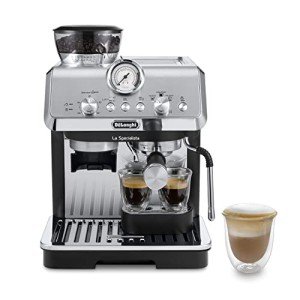The Rise of Home Espresso Machines: A Comprehensive Guide
As coffee enthusiasts continue to look for fresh and delicious brews in the house, the appeal of home espresso machines has actually risen recently. No longer simply the domain of cafes and cafe, these machines empower individuals to craft barista-quality espresso drinks from the convenience of their cooking areas. This short article will explore the various types of home espresso machines, their functions, and factors to consider for choosing the ideal one. Additionally, it will supply a choice of FAQs to assist prospective purchasers make notified decisions.
Kinds Of Home Espresso Machines
Home espresso machines can be categorized into several classifications based upon their systems and user-friendliness. Each type has its special features, pros, and cons.
| Type | Description | Pros | Cons |
|---|---|---|---|
| Manual Espresso Machines | Needs the user to manually control the brewing process, involving techniques like pulling a lever to develop pressure. | - Complete control over brewing procedure - Compact style | - Requires ability and practice - Time-consuming |
| Semi-Automatic Machines | Machine automates water circulation and pressure, however the user still controls the dosing and duration of the brewing process. | - Balance of automation and control - Versatile | - Learning curve for perfecting methods |
| Fully Automatic Machines | Automates the entire developing process, from grinding to developing, frequently with programmable settings for customized beverages. | - Extremely user-friendly - Quick and hassle-free | - Less control over the brewing process - Higher price point |
| Capsule or Pod Machines | Uses pre-packaged espresso pills or pods to produce coffee rapidly and easily. | - Extremely easy to use - Minimal clean-up | - Limited flavor variety - More expensive per cup than ground coffee |
| Super-Automatic Machines | Integrates features of fully automatic machines with built-in mills, permitting users to brew whole bean espresso and milk-based beverages with one touch. | - All-in-one benefit - Ideal for milk-based beverages | - Often the most expensive - Can be large |
Functions to Consider
When picking a home espresso machine, prospective buyers ought to think about the following features to guarantee they pick a machine that fulfills their requirements:
Grinder Type:
- Built-in mills can supply fresher premises but might need more upkeep.
- Different grinders permit more customization of grind size.
Pressure:
- Look for machines that produce at least nine bars of pressure, which is optimum for brewing espresso.
Water Temperature Control:
- Machines with adjustable temperature level settings enable much better extraction of flavor from beans.
Milk Frothing Options:
- Consider whether you want a manual steam wand for frothing or an automatic milk frother for benefit.
Alleviate of Cleaning:
- Machines with removable parts and self-cleaning functions considerably decrease clean-up time.
Size and Design:
- Ensure the machine fits conveniently in your kitchen area and aligns with your aesthetic preferences.
Budget:
- Set a budget before starting your search, as costs can range considerably from affordable designs to high-end machines.
Advantages of Home Espresso Machines
Owning a home espresso machine offers many benefits:
- Cost-Effective: Over time, brewing espresso at home can conserve coffee enthusiasts money compared to frequent coffee shop check outs.
- Modification: Users can try out various beans, grind sizes, and brewing strategies to find their best cup.
- Convenience: The capability to brew espresso any time eliminates the requirement to head out to a coffee shop, specifically useful during late nights or mornings.
- Quality Control: With a home machine, people have complete control over the quality of components and brewing processes.
Disadvantages of Home Espresso Machines
However, there are some drawbacks to think about:
- Initial Investment: High-quality espresso machines can be costly, needing a significant in advance investment.
- Knowing Curve: Mastering the art of espresso brewing can require time and practice, which may be frightening for newbies.
- Upkeep: Like any device, espresso machines need regular cleaning and upkeep to make sure optimum efficiency.
FAQs
1. What is the very best type of home espresso machine for novices?
Answer: For newbies, a semi-automatic machine is often advised as it offers a balance in between control and automation, enabling you to learn the fundamentals without frustrating intricacy.
2. Just how much should I invest in a home espresso machine?
Answer: Entry-level machines can start around ₤ 100 to ₤ 300, while higher-end models can range from ₤ 500 to over ₤ 2000. It's vital to set a budget based upon your expected usage and wanted functions.
3. Do I require a different grinder?
Response: While some espresso machines come with built-in grinders, purchasing a different grinder permits higher modification and guarantees much better quality premises.
4. How typically should I clean my espresso machine?
Response: Cleaning frequency can differ by machine type, but it's usually suggested to clean the machine after each use and carry out deep cleanings weekly or month-to-month, depending on use.
5. Can I make milk-based drinks with any espresso machine?
Answer: Not all machines feature milk frothing abilities. If you enjoy drinks like lattes or cappuccinos, look for a machine with a steam wand or automatic frother.
Home espresso machines are transforming the way coffee fanatics enjoy their precious brews. With Read the Full Posting and advanced features available in the market, there is something for everybody. Whether it's the joy of developing special dishes or simply savoring the ideal shot of espresso, buying a home espresso machine can enhance both the coffee-drinking experience and the lifestyle for coffee lovers all over. Similar to any financial investment, it is essential to weigh the advantages against the prospective downsides and choose a machine that seamlessly fits both your lifestyle and choices.

